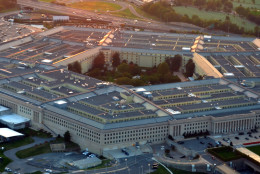Center for Strategic and International Studies
-
Andrew Hunter of the Center for Strategic and International Studies joined Off the Shelf to discuss current trends in defense acquisition and the artificial intelligence ecosystem in national security.
January 08, 2019 -
The Defense Department is talking the talk, but there is no walk in the spending numbers.
November 28, 2018 -
A new report estimates the space force might cost between $300 million and $550 million - less than initially predicted.
November 20, 2018 -
Mark Cancian, senior adviser for the international security program at the Center for Strategic and International Studies, joined Federal Drive with Tom Temin to share his analysis of the 2019 defense budget.
November 13, 2018 -
A report from the Center for Strategic and International Studies says the federal government needs a bigger role in helping state and local police access digital evidence.
August 13, 2018 -
Continuing resolutions temporarily evade shutdowns, but they may also hurt the Department of Defense’s readiness long-term.
January 19, 2018 -
Congress is trying to avert a shutdown, but some are concerned a continuing resolution could trigger sequestration.
January 19, 2018 -
The Defense Department released a report about splitting the office of the undersecretary of Defense for Acquisition, Technology and Logistics in two, and standing up the new position of chief management officer.
August 03, 2017 -
More than 30 think tank experts are calling for military base closures. The Defense Department says it is operating with a 22 percent excess of infrastructure.
June 19, 2017 -
By most measures, the 44 year experiment in an all-volunteer military force has been a success. But like stocks, past performance doesn't guarantee the future. In fact, the all-volunteer force is showing serious strains.
May 01, 2017 -
After years of steady declines, spending on contracts by the armed forces and Defense agencies are heading back up. Andrew Hunter, director of the defense-industrial initiatives group at the Center for Strategic and International Studies, joins Federal Drive with Tom Temin with more.
April 26, 2017 -
The Defense Innovation Unit Experimental is still awarding contracts despite months of uncertainty.
April 20, 2017 -
In today's Federal Headlines, the amount of money the Defense Department dedicated towards contract spending rose last year.
April 07, 2017 -
The third offset strategy was born under the Obama administration, but it may still have life under the Trump presidency. On Federal Drive with Tom Temin DoD reporter Scott Maucione speaks with Andrew Hunter, senior fellow at the Center for Strategic and International Studies about what the third offset means under the new administration and where it’s going.
March 27, 2017 -
Todd Harrison, director of defense budget analysis at the Center for Strategic and International Studies, discusses what a 10 percent increase in defense funding would actually buy.
March 27, 2017















